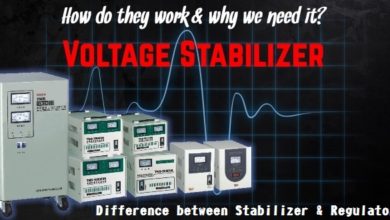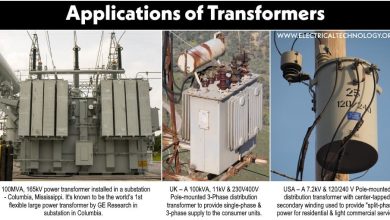Losses in a DC Motor – Power Stages & Efficiency of DC Motor
Losses, Power Stages and Efficiency of a DC Motor
Losses in a DC Motor
It is a universal truth that the output of a DC machine (DC motor or DC generator) is always less than the input because there are some losses due to different factors in the DC machines. The losses in a DC motor are the same as losses in a DC generator except the power flow.
As the same DC machine can be used for different purposes e.g. DC motor converts the electrical power into mechanical power while the DC generator converts the mechanical power into electrical power.
It is a fact that the input power to the motor input in VI – Watts are not fully converted into mechanical power in BHP x 746 – Watts because some losses (copper, iron and rotational or friction losses) occur during the power conversion. These losses are known as motor losses which dissipate in the form of heat.
If the losses in a motor increases, it will decrease the motor’s efficiency. If more losses occur, it may lead to burning the motor at all. A good DC motor is that with fewer amounts of losses and better efficiency.
There are some losses that occur in a DC motor during the power conversion which can be classified as follows.
- Electrical Losses = Copper Losses
- Magnetic or Machine Losses = Iron Core Losses
- Mechanical Losses = Friction & Windage or Rotational Losses
Let’s briefly discuss one by one as below:
Electrical Losses (Copper Losses)
When current flows through conductors, the I2R losses occur due to the resistance of conductors which is known as copper losses. These losses can be further categorized as follow:
Armature Copper Loss
When current flows through the armature winding (conductors), some losses occur due to the resistance of armature winding conductors. These losses are 30-40% of the total full load losses which can be calculated as:
Ia2Ra … Watts
Where
- Ia = Armature current
- Ra = Armature resistance
Field Copper Loss
When current flows through the shunt field and series field, (in case of shunt and series motor and generator respectively) some losses occur due to the resistance of these fields winding.
Additionally, the losses occur due to the winding resistance when a current flow in the interpole winding conductors is known as interpole winding losses.
These losses are 20-30% of the total full load losses which can be calculated as:
Shunt Field Losses = Ish2Rsh … Watts
Series Field Losses = Ise2Rse … Watts
Interpole Winding Losses = Ia2R2 … Watts
Where
- Ish, Ise & Ia = Current in shunt field, series field and armature windings respectively.
- Rsh, Rse & R2 = Resistance of shunt field, series field & armature windings respectively.
Brush Contact Resistance Loss
As the name suggests, these losses occur due to the brush resistance during the surface mechanism operation of the brush and commutator. Generally, these losses are categorized in the armature losses.
PBrush = VDB Ia
Where: PBrush is the power loss at brushes while VDB is the voltage drop at brushes.
Hence, the total copper loss in a DC motor:
Total Cu. Loss = Ia2Ra + Ish2Rsh + Ise2Rse
Related Posts:
- Losses in a DC Generator – Power Stages & Efficiency of DC Generator
- Losses in Alternator – Power Stages & Efficiency of Synchronous Generator
Magnetic Losses (Iron Core Losses)
Magnetic losses are known as iron core losses (which are 30-40% of the full load losses) and have additional types as follows.
Hysteresis Loss
The losses due to the reversal of magnetism in the armature core are known as hysteresis losses. Each part of the rotational core passes below the “S” and “N” pole again and again which changes the polarity of “S” and “N” respectively. Due to these polarity changes, hysteresis losses occur which depends on flux and speed of motor.
These losses can be determined using the following formula.
Hysteresis Losses = WHys ∝ BMax1.6 fV
Where:
- WHys = Hysteresis Losses
- BMax = Maximum flux density
- f = Frequency
- V = Volume of the core
Eddy Current Loss
When the armature core rotates in the magnetic field, an EMF is induced in it according to the law’s of electromagnetic induction. As the resistance of the core is very low (where the core area is noticeably large) hence, a huge amount of current flows in it which causes more losses. The power loss due to eddy current is known as eddy current losses.
To reduce the eddy current loss (this power dissipation appears in the form of heat), a laminated (each core lamination is laminated from each other) core is used instead of solid core. The eddy current loss can’t be fully eliminated, but minimize using the laminated core. These losses can be calculated using the following formula.
Eddy Current Losses = WEddy ∝ BMax2f2t2V
Where:
- WEddy = Eddy Current Losses
- BMax = Maximum flux density
- f = Frequency
- t = Width of limitation
- V = Volume of the core
Related Posts:
- Losses in a Induction Motor – Power Stages in Induction Motors
- Losses in Synchronous Motor – Power Stages & Efficiency of Synchronous Motors
Mechanical Losses (Friction & Windage or Rotational Losses)
Mechanical losses are also known as friction losses or rotational losses. These losses can be classified as follows.
Friction Losses
These losses occur due to the friction between the surfaces of the brush to commutator and bearings to the shaft connected to the armature (shaft).
Windage Losses
Windage losses occur when air opposes the rotation of the armature. This is because the rotating armature needs to be pushed against the wind to rotate in the defined direction.
Stray Losses:
Frictional losses (mechanical losses) and iron losses (magnetic losses) are known as stray losses.
Constant Losses:
Iron and friction losses and shunt field losses are constant in shunt and compound DC machines.
Variable Losses:
These losses vary and change according to behavior of the load current. For example:
- I2R losses in the armature
- I2R losses in the series winding
- I2R losses in the interpole winding
Hence, total losses of the DC Motor are:
Total Losses = Constant Losses + Variable Losses
Related Posts:
- Losses in Electrical Machines – Formulas and Equations
- Transformer Losses – Different Types of Losses in a Transformer
Power Stages in DC Motor
When a DC motor converts input electrical energy into output mechanical energy, there are some losses during the process of energy conversion. For this reason, the output of the DC motor is always less than the input. All the DC motor’s losses during the energy conversion in the machine at different stages is known as power stages of the DC motor as shown in fig below.
The motor input is in VI watts. The initial losses occur in the form of copper losses. The copper loss minus input power is known as driving power developed power in the armature (EbIa). Now some additional losses occur in the form of iron and friction losses. Now the iron and friction losses – driving power is the net mechanical power available at the shaft.
The losses and efficiencies can be determined using the following formulas and equations.
A – B = Copper losses
B – C = Iron and friction losses
Mechanical Efficiency = ηM = C ÷ B = (B.H.P × 746) ÷ EbIa
Electrical Efficiency = ηE = B ÷ A = EbIa ÷ VI
Overall (Commercial) Efficiency = ηC = C ÷ A = (B.H.P × 746) ÷ VI
Keep in mind that there is a difference between BHP (Break horse power) and HP (horse power) where:
- BHB = Mechanical power available at the shaft
- HP = A motor which needs electric power as input in HP x 746 watts to run and operate.
Related Post:
- What is Motor Efficiency and How to improve it?
- Transformer Efficiency, All day Efficiency & Condition for Maximum Efficiency
Efficiency of DC Motor
The ratio between input and output of a machine is defined as the efficiency of machine. It is expressed in persentage (%) and denoted by the greek symbol “η”.
Efficiency = η = (Output ÷ Input) × 100
There are some losses in each machine, this way, the output is always less than the input. e.g.
Output = Input – Losses
Input = Output + Losses
Therefore, the efficiency can also be determined as follows:
Efficiency = η = (Input – Losses) ÷ Input)) × 100
Efficiency = η = (Output ÷ (Output + Losses)) × 100
The following fig shows the efficiency curve of a DC motor (similar to DC generator) i.e. efficiency curve of a DC machine.
Related Posts:
- Single-Phase Induction Motor – Construction, Working, Types & Applications
- Three-Phase Induction Motor – Construction, Working, Types & Applications
- Alternator or Synchronous Generator: Construction, Working, Types & Applications
- Synchronous Motor: Construction, Working, Types & Applications
- Synchronous, Stepper and AC Motors Formulas and Equations
- EMF Equation of an Alternator and Synchronous Generator
- Torque Equation of Induction Motor
- EMF Equation of a Transformer
- Power, Voltage and EMF Equation of a DC Motor
- Equivalent Circuit of Induction Motor
- Equivalent Circuit of Electrical Transformer
- Difference between Synchronous and Asynchronous Motor









